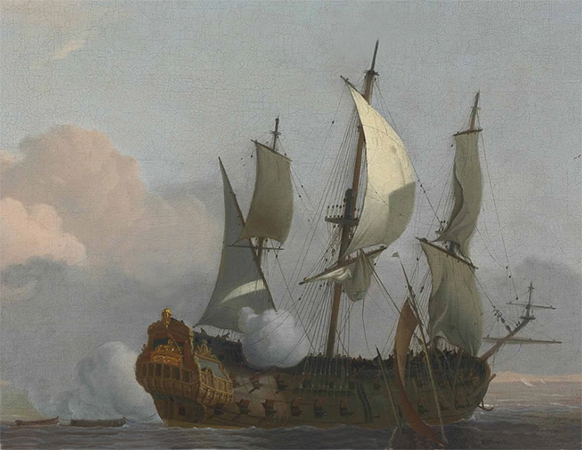The idea that Dutch privateers should have ended up among the Barbary corsairs of North Africa may at first seem unlikely, but it turns out to be one of those historical associations which, seen in retrospect, seems almost inevitable.
The early seventeenth century was a time of violent upheaval throughout Europe. The discovery of the New World—and the riches that could be extracted from it—led to bitter conflicts. The Reformation and Counter-Reformation led to even more bitter conflicts. In the fifty years spanning the last quarter of the sixteenth and the first quarter of the seventeenth centuries, there were no less than seventeen major wars fought on European soil, plus numerous violent rebellions within individual European nations. And while these various clashes were playing out, there was also an ongoing, fierce struggle between the European powers and the Ottoman Empire.
One of the longest of the European conflicts was the Eighty Years’ War (1568-1648), the Republic of the Netherlands’ battle for independence from the Spanish Hapsburg Empire.
The Dutch/North African connection has its roots in that conflict.
The Dutch, especially at the beginning of the war, suffered from a perennial lack of needed resources. They were short on weapons, short on soldiers, short on ships. A number of immediate causes accounted for this: the despoiling of the Dutch provinces by the Spanish authorities overseeing them, losses in battle once the rebellion against the Spanish Hapsburgs was launched, the relative smallness and concomitant lack of resources of the rebellious provinces themselves.
There was also a more fundamental underlying problem, though.
Seventeenth century European countries were not the sort of nation states they are now. One of the main ways they differed was that they lacked the massive, stable tax base that modern nation states rely on. Among other things, this lack of a tax base meant that seventeenth century countries had difficulty maintaining permanent military forces. This was a challenge even for a large country like Spain, with vast quantities of silver and gold arriving annually from the New World. It was an especially painful problem for the nascent Republic of the Netherlands.
The Eighty years’ War, like so many wars, was fought both on land and at sea. Fielding an army required a huge initial outlay and was obscenely expensive, so a military loss also meant a financial loss, in some cases a catastrophic financial loss. There was simply no way around that. There was, however, a way to finesse the financing of naval forces. Though it was necessary to bankroll and equip a standing navy—there was no way around that, either—the standing navy could be augmented by an irregular supporting force of privateers.
Privateers were private individuals—that is, not regular naval personnel—equipped with legal authorization from their government to attack enemy ships and steal merchandise from them, and frequently to steal the ships themselves.
The Republic of the Netherlands (and other European countries as well) made extensive use of privateers, for they presented a nearly perfect solution to the problem of financing naval operations. The government provided legal cover for the privateer in the form of an official license, usually referred to as a letter of marque. A privateer in possession of such a license was given legal sanction to attack ‘enemy’ shipping—the definition of ‘enemy’ being given in the letter of marque. As long as the privateer kept within the bounds of his letter of marque, everything he did was completely legal.
In other words, a privateer was a lawfully authorized pirate.
The beauty of this system from the government’s perspective was that the costs of equipping a privateering expedition were born entirely by the privateers themselves and by the financial backers of individual privateer ships. The profits, however, were shared with the government. So the use of privateers allowed the Republic of the Netherlands to increase the number of armed ships available for the conflict against Spain without having to incur the expenses necessary to permanently enlarge their navy—while at the same time bringing in much needed extra revenue.
A perfect solution.
Almost.
There was a recurring problem with privateers.
They may have been licensed pirates, but they were still pirates, making their living by plundering others. The temptation to cross the line between officially licensed, regulated privateer and lawless pirate was always there. After all, why go through the huge risk involved in attacking other ships, only to have to give away a large part of the spoils to financial backers and government officials who sat back at home and did nothing more strenuous than cozy up to a warm hearth and toast their good fortune with goblets of fine imported wine?
Also, effective privateers were aggressive risk takers, and in the heat of action they could all too easily transcend the strict limits of their commissions and find themselves outside the law, even if they had not originally intended to be. Beyond all that, privateering, like piracy of any sort, was a violent business that corroded the men who practice it, so that violence became virtually all they knew. These sorts of men were difficult to constrain with mere pieces of paper.
So right from the earliest days of the famous Dutch Sea Beggars onward, controlling the swarms of privateers the States General employed was a challenge, and there were always rogues who ended up operating outside of any restraint.
A formal system was worked out, though, that kept such rogues in check—or at least kept them in check enough—so that for two generations the government-sponsored Dutch privateers functioned effectively as a (loosely) organized fighting force that was not only militarily successfully against the Spanish but also hugely profitable.
And then… everything changed.
To find out what that change was, go to The Dutch Connection: How Seventeenth Century Dutch Privateers Became Barbary Corsairs in North Africa – Part 2.
 The Travels of Reverend Ólafur Egilsson
The Travels of Reverend Ólafur Egilsson
The story of the Barbary corsair raid on Iceland in 1627
Amazon listing